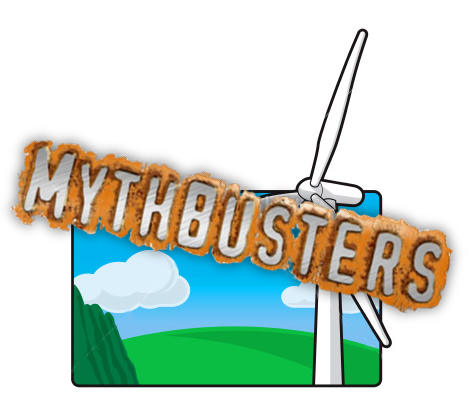Top 10 Wind Energy Myths… Busted!
Here are our favourite “wind myths” compiled from various sources including Renewable UK. For a very in-depth and well researched discussion of all the issues please take look at the recently published report by the Centre for Sustainable Energy.

 Wind turbines are dangerous
Wind turbines are dangerous
Wind energy is a benign technology with no associated emissions, harmful pollutants or waste products. In over 25 years and with more than 68,000 machines installed around the world15, no member of the public has ever been harmed by the normal operation of wind turbines.
 Wind turbine noise damages your health
Wind turbine noise damages your health
In response to unscientific accusations that wind turbines emit infrasound and cause associated health problems, Dr Geoff Leventhall, Consultant in Noise Vibration and Acoustics and author of the Defra Report on Low Frequency Noise and its Effects, says: “I can state quite categorically that there is no significant infrasound from current designs of wind turbines. To say that there is an infrasound problem is one of the hares which objectors to wind farms like to run. There will not be any effects from infrasound from the turbines.” More Info…
More recent research suggests that the way in which people respond to wind farms is somewhat determined by their pre-disposition for or against. People fearing that a wind farm will negatively affect their health tend to the same people who later on report such affects. This is not to say the reports are in any way made up, but suggests a possible psychosomatic link.
Similarly there is no evidence in the UK for wind turbine noise causing illness in animals and in particular equines. The British Horse Society (who publish up-to-date guidance on the issue) confirm there is no evidence of ill affects in the UK. Conversely there are now more and more equine businesses exploiting the natural resources at their disposal.
 Wind turbines kill 1000s of birds
Wind turbines kill 1000s of birds
The RSPB stated in its 2004 information leaflet Wind farms and birds, that “in the UK, we have not so far witnessed any major adverse effects on birds associated with wind farms”. Moreover, a report published in the journal Nature confirmed that the greatest threat to bird populations in the UK is climate change.
 Wind turbines are ugly and unpopular
Wind turbines are ugly and unpopular
Beauty is in the eye of the beholder, and whether you think a wind turbine is attractive or not will always be your personal opinion. However, studies have shown that 80% of the public support wind energy, less than 10% are against it, with the remainder undecided. Surveys conducted since the early 1990’s across the country near existing wind farms have consistently found that most people are in favour of wind energy , with support increasing among those living closer to the wind farms. The very latest research from the DECC shows wind still as popular as ever with overwhelming UK majority support.
When the Eiffel Tower was first constructed in 1887 it was almost universally hated. Newspapers of the day were filled with angry letters; one is quoted extensively in William Watson’s US Government Printing Office publication of 1892 Paris Universal Exposition: Civil Engineering, Public Works, and Architecture: “And during twenty years we shall see, stretching over the entire city, still thrilling with the genius of so many centuries, we shall see stretching out like a black blot the odious shadow of the odious column built up of riveted iron plates”.
There are some striking similarities between public perceptions regarding the Eiffel tower then and wind turbines today.
 Wind turbines are inefficient and only work 30% of the time
Wind turbines are inefficient and only work 30% of the time
A modern wind turbine produces electricity 70-85% of the time, but it generates different outputs depending on the wind speed. Over the course of a year, it will typically generate about 30% of the theoretical maximum output. This is known as its load factor. The load factor of conventional power stations is on average 50%.
Most forms of renewable energy are intermittent which represents a challenge to the traditional energy systems we have. Over time new “grid level” energy storage solutions will become available that allows renewable energy to be stored and used when needed.
 Wind turbines damage the landscape
Wind turbines damage the landscape
Wind turbines have a lifespan of approximately 25 years. If, as promised, clean and safe Nuclear Fusion energy were to become a reality within this time there would be no further need for wind turbines and they would gradually be removed without trace.
 Wind energy is more expensive
Wind energy is more expensive
The cost of generating electricity from wind has fallen dramatically over the past few years. Wind energy is now competitive with new coal and nuclear capacity, even before any environmental costs of fossil fuel and nuclear generation are taken into account. The average cost of generating electricity from onshore wind is now around 3-4p per kilowatt hour, competitive with new coal (2.5-4.5p) and cheaper than new nuclear (4-7p). As gas prices increase and wind power costs fall – both of which are very likely – wind becomes even more competitive.
The Department for Energy and Climate Change (DECC) maintain that onshore wind is the cheapest of all large scale renewable technologies while Government subsidies such as ROCs and FITs are reducing year-by-year and increasing the competitiveness still further.
 Wind turbines affect tourism
Wind turbines affect tourism
There is no evidence to suggest this. The UK’s first commercial wind farm at Delabole received 350,000 visitors in its first ten years of operation, while 10,000 visitors a year come to take the turbine tour at the EcoTech Centre in Swaffham, Norfolk. A MORI poll in Scotland showed that 80% of tourists would be interested in visiting a wind farm. Wind farm developers are often asked to provide visitor centres, viewing platforms and rights of way to their sites.
In a countless number of planning appeals, Government inspectors have continuously rejected claims that wind turbines damage tourism citing a total lack of evidence. In fact this whole argument can be countered with a single word – Cornwall.
 Wind turbines affect house prices
Wind turbines affect house prices
There is currently no hard evidence in the UK showing that wind farms impact house prices. However, there is evidence following a comprehensive study by the Scottish Executive that those living nearest to wind farms are their strongest advocates. New evidence from independent research group CEBR still finds no evidence.
As of early 2014 there are still strong concerns of an “overheating housing market” in the UK with annual inflation running at 9%. While local factors may introduce short term volatility the overall trend for all property is up even in areas with large numbers of wind turbines.
 Wind turbines are very noisy
Wind turbines are very noisy
The evolution of wind farm technology over the past decade has rendered mechanical noise from turbines almost undetectable with the main sound being the aerodynamic swoosh of the blades passing the tower. There are strict guidelines on wind turbines and noise emissions to ensure the protection of residential amenity. These are contained in the scientifically informed ETSU Working Group guidelines 1996 and must be followed by wind farm developers, as referenced in national planning policy for renewables. The best advice for any doubter is to go and hear for yourself!
Source: BWEA
